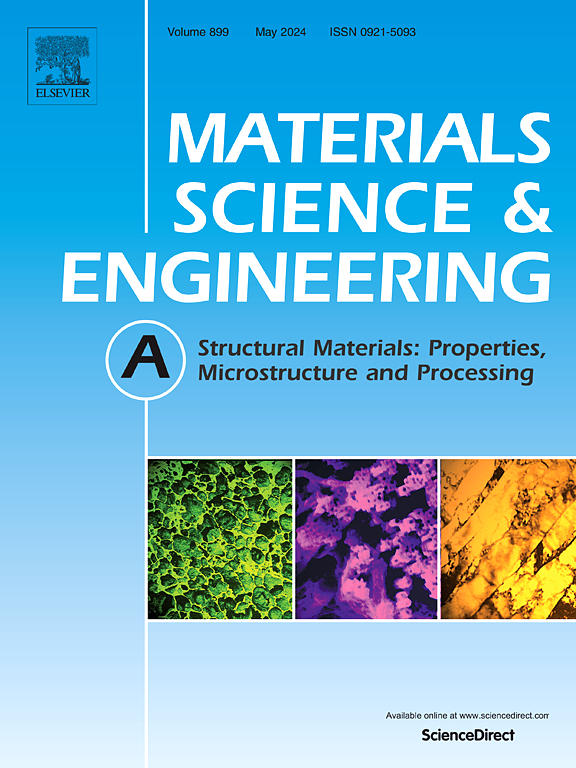激光粉末床熔合Ti-55511合金热处理层状组织断裂韧性增强研究
IF 6.1
2区 材料科学
Q1 MATERIALS SCIENCE, MULTIDISCIPLINARY
引用次数: 0
摘要
采用激光粉末床熔合(LPBF)制备的近β钛合金Ti-5Al-5Mo-5V-1Cr-1Fe (Ti-55511)具有非均质显微组织,主要表现为具有强织构的柱状优先-β晶粒。这些各向异性的微观结构通常会导致裂纹扩展过程中的抗断裂能力降低,从而限制了其高性能应用的潜力。为了解决这一问题,研究人员开发了一种新的三步热处理方法,包括在β温度附近进行固溶处理,然后进行双阶段时效处理。这种定制热处理不仅细化了组织,而且诱导了分层α相组织的形成,其特征是均匀分布在等轴β晶粒内的第三系α相。具体而言,lpbf制备的Ti-55511样品具有优异的综合力学性能,包括屈服强度超过1100 MPa,延展性大于10%,断裂韧性超过72.9±3.9 MPa m1/2。该研究阐明了多级热处理控制纳米级次级α相(宽度~ 50 nm)、亚微米α相(宽度~ 500 nm)和初级α相(宽度~ 1 μm)形成的机制,从而形成了增强强度和韧性的分层微观结构。断裂韧性的提高主要归因于α相的优化分布,通过促进裂纹挠曲和桥接机制有效抑制裂纹扩展。这项工作为lpbf处理Ti-55511合金的分层组织演变与力学行为之间的关系提供了新的见解,为增强增材制造钛合金的抗断裂能力提供了一条有希望的途径。本文章由计算机程序翻译,如有差异,请以英文原文为准。
Fracture toughness enhancement of a laser powder bed fusion manufactured Ti-55511 alloy with a heat-treatment-tailored hierarchical microstructure
Near-β titanium alloy Ti–5Al–5Mo–5V–1Cr–1Fe (Ti-55511), fabricated using laser powder bed fusion (LPBF), typically exhibits heterogeneous microstructures characterized by strongly textured columnar prior-β grains. These anisotropic microstructures often lead to reduced fracture resistance during crack growth, limiting its potential for high-performance applications. To address this challenge, a novel three-step heat treatment was developed, comprising solution treatment near the β transus temperature, followed by a double-stage aging process. This tailored heat treatment not only refined the microstructure but also induced the formation of a hierarchical α phase structure, characterized by uniformly distributed tertiary α phases within equiaxed β grains. Specifically, the LPBF-fabricated Ti-55511 samples demonstrated an excellent combination of mechanical properties, including a yield strength exceeding 1100 MPa, ductility greater than 10 %, and fracture toughness exceeding 72.9 ± 3.9 MPa m1/2. This study elucidated the mechanisms by which multi-stage heat treatments govern the formation of nano-scale secondary α phases (width ∼ 50 nm), sub-micron α phases (width ∼ 500 nm), and primary α phases (width ∼ 1 μm), creating a hierarchical microstructure that enhances both strength and toughness. The observed improvements in fracture toughness were attributed to the optimized distribution of α phases, which effectively suppressed crack propagation by promoting crack deflection and bridging mechanisms. This work provides new insights into the relationship between hierarchical microstructural evolution and mechanical behavior in LPBF-processed Ti-55511 alloys, offering a promising pathway for enhancing the fracture resistance of additively manufactured titanium alloys.
求助全文
通过发布文献求助,成功后即可免费获取论文全文。
去求助
来源期刊

Materials Science and Engineering: A
工程技术-材料科学:综合
CiteScore
11.50
自引率
15.60%
发文量
1811
审稿时长
31 days
期刊介绍:
Materials Science and Engineering A provides an international medium for the publication of theoretical and experimental studies related to the load-bearing capacity of materials as influenced by their basic properties, processing history, microstructure and operating environment. Appropriate submissions to Materials Science and Engineering A should include scientific and/or engineering factors which affect the microstructure - strength relationships of materials and report the changes to mechanical behavior.
 求助内容:
求助内容: 应助结果提醒方式:
应助结果提醒方式:


